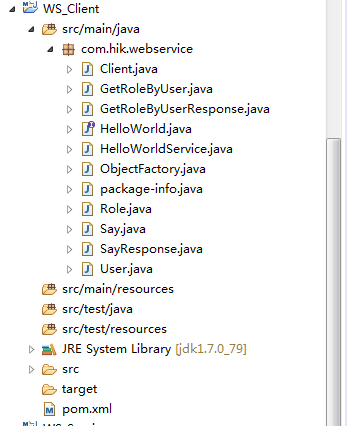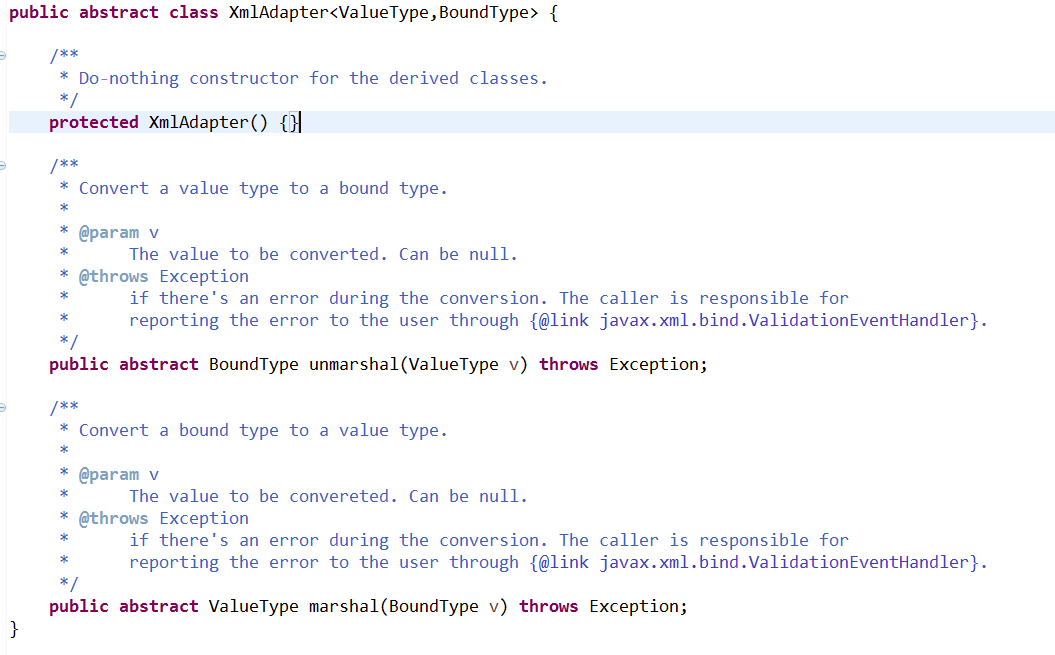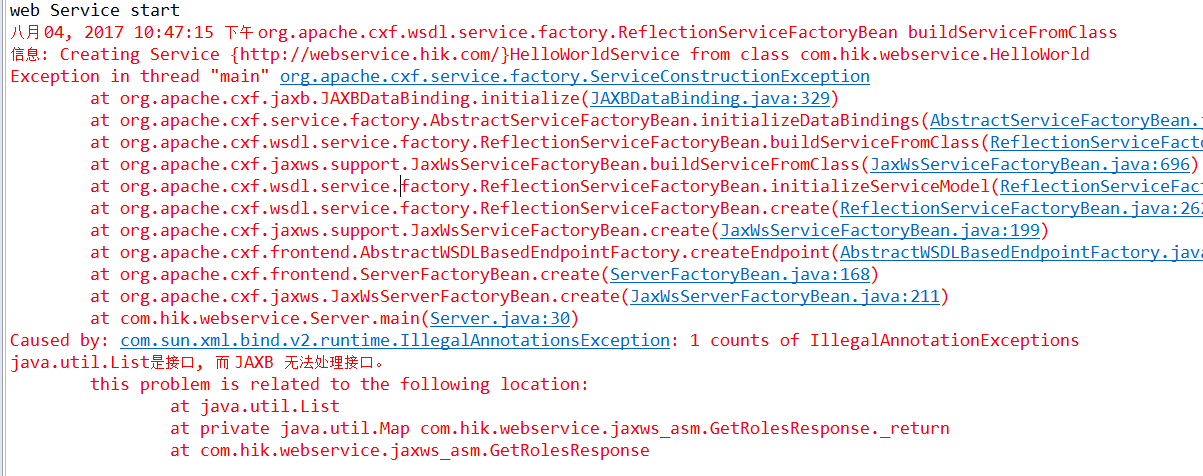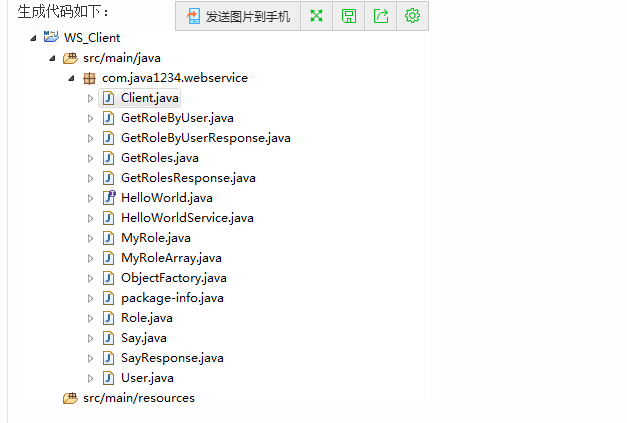项目中经常是处理复合类型比如集合List、Map,下面就cxf处理复合类型进行讲解。
具体例子如下:
这里实例是客户端传一个JavaBean,服务器端返回集合类型;
一、 接口返回List处理:
在原来的项目实例(cxf开发webService服务端口)基础上,我们先创建一个实体类User:

1 /** 2 * 3 */ 4 package com.hik.entity; 5 6 /** 7 * @ClassName: User 8 * @Description: 用户实体类 9 * @author jed 10 * @date 2017年7月30日下午2:44:41 11 * 12 */ 13 public class User { 14 15 private Integer id; // 编号 16 private String userName; //用户名 17 private String password; //密码 18 19 public Integer getId() { 20 return id; 21 } 22 public void setId(Integer id) { 23 this.id = id; 24 } 25 public String getUserName() { 26 return userName; 27 } 28 public void setUserName(String userName) { 29 this.userName = userName; 30 } 31 public String getPassword() { 32 return password; 33 } 34 public void setPassword(String password) { 35 this.password = password; 36 } 37 38 39 }
再创建一个Role实体类:

1 /** 2 * 3 */ 4 package com.hik.entity; 5 6 /** 7 * @ClassName: Role 8 * @Description: TODO 9 * @author jed 10 * @date 2017年7月30日下午2:46:45 11 * 12 */ 13 public class Role { 14 15 private Integer id; //编号 16 private String roleName; //角色名称 17 18 public Role() { 19 super(); 20 } 21 22 public Role(Integer id, String roleName) { 23 super(); 24 this.id = id; 25 this.roleName = roleName; 26 } 27 28 public Integer getId() { 29 return id; 30 } 31 public void setId(Integer id) { 32 this.id = id; 33 } 34 public String getRoleName() { 35 return roleName; 36 } 37 public void setRoleName(String roleName) { 38 this.roleName = roleName; 39 } 40 41 42 }
然后HelloWorld再加一个接口方法getRoleByUser,通过用户查找角色:

1 /** 2 * 3 */ 4 package com.hik.webservice; 5 6 import java.util.List; 7 8 import javax.jws.WebService; 9 10 import com.hik.entity.Role; 11 import com.hik.entity.User; 12 13 /** 14 * @ClassName: HelloWorld 15 * @Description: TODO 16 * @author jed 17 * @date 2017年7月30日上午10:20:35 18 * 19 */ 20 @WebService 21 public interface HelloWorld { 22 23 public String say(String str); 24 25 public List<Role> getRoleByUser(User user); 26 }
然后HelloWorld接口实现类 HelloWorldImpl写下新增的方法的具体实现,我们这里写死,模拟下即可:

1 /** 2 * 3 */ 4 package com.hik.webservice.impl; 5 6 import java.util.ArrayList; 7 import java.util.List; 8 9 import javax.jws.WebService; 10 11 import com.hik.entity.Role; 12 import com.hik.entity.User; 13 import com.hik.webservice.HelloWorld; 14 15 /** 16 * @ClassName: HelloWorldImpl 17 * @Description: TODO 18 * @author jed 19 * @date 2017年7月30日上午10:24:46 20 * 21 */ 22 @WebService 23 public class HelloWorldImpl implements HelloWorld{ 24 25 public String say(String str) { 26 return "hello "+str; 27 } 28 29 public List<Role> getRoleByUser(User user) { 30 List<Role> roleList = new ArrayList<Role>(); 31 if(user!=null){ 32 if(user.getUserName().equals("jack") && user.getPassword().equals("123456")){ 33 roleList.add(new Role(1, "技术总监")); 34 roleList.add(new Role(2, "产品经理")); 35 }else if(user.getUserName().equals("lili") && user.getPassword().equals("123456")){ 36 roleList.add(new Role(3, "程序员")); 37 } 38 return roleList; 39 }else{ 40 return null; 41 } 42 43 } 44 45 }
服务端其他地方不用动;再重新发布下webService接口。
下面我们来处理下客户端,和前面讲的一样。我们用wsdl2java工具重新生成代码(参考cxf开发webService客户端及调用服务端的理解 )

我们改下Client类:

1 /** 2 * 3 */ 4 package com.hik.webservice; 5 6 import java.util.List; 7 8 /** 9 * @ClassName: Client 10 * @Description: TODO 11 * @author jed 12 * @date 2017年7月30日下午1:58:36 13 * 14 */ 15 public class Client { 16 17 public static void main(String[] args) { 18 HelloWorldService service = new HelloWorldService(); 19 HelloWorld helloWorld = service.getHelloWorldPort(); //代理 20 //System.out.println(helloWorld.say("你好!")); 21 User user = new User(); 22 user.setUserName("lili"); 23 user.setPassword("123456"); 24 List<Role> roleList = helloWorld.getRoleByUser(user); 25 for(Role role : roleList){ 26 System.out.println(role.getId()+" , "+role.getRoleName()); 27 } 28 } 29 }
运行截图:

二、接口返回Map处理
map类型比较特殊,由其数据结构而决定。XmlAdapter类源码也有说明:

因此,需要写一个适配器来做转换,使用注解annotation注解 。该适配器类需实现抽象类XmlAdapter的两个转换方法。


代码例子如下:
如增加接口:获取所有用用户以及对应的每个用户所有角色信息;
服务器端:
HelloWorld接口加方法:

1 /** 2 * 3 * @MethodName: getRoles 4 * @Description: 获取所有用户及对应角色 5 * @author jed 6 * @date 2017年8月4日下午10:36:59 7 * @param @return 8 * @return Map<String,List<Role>> 返回类型 9 * @return 10 * 11 */ 12 @XmlJavaTypeAdapter(MapAdapter.class) 13 public Map<String, List<Role>> getRoles();
HelloWorldImpl实现类加方法实现:

1 public Map<String, List<Role>> getRoles() { 2 Map<String, List<Role>> map = new HashMap<String, List<Role>>(); 3 List<Role> roleList1 = new ArrayList<Role>(); 4 roleList1.add(new Role(1, "技术总监")); 5 roleList1.add(new Role(2, "产品经理")); 6 map.put("admin", roleList1); 7 List<Role> roleList2 = new ArrayList<Role>(); 8 roleList2.add(new Role(3, "程序员")); 9 map.put("jack", roleList2); 10 return map; 11 }
然后我们启动Server类:发现报错:

报错显示不支持该类型,解决方案,可以使用适配器,把cxf不能接受的类型通过适配器,转能接受的类型。
我们使用@XmlJavaTypeAdapter注解,加在接口定义上,完整接口代码如下:

1 /** 2 * 3 */ 4 package com.hik.webservice; 5 6 import java.util.List; 7 import java.util.Map; 8 9 import javax.jws.WebService; 10 import javax.xml.bind.annotation.adapters.XmlJavaTypeAdapter; 11 12 import com.hik.adapter.MapAdapter; 13 import com.hik.entity.Role; 14 import com.hik.entity.User; 15 16 /** 17 * @ClassName: HelloWorld 18 * @Description: TODO 19 * @author jed 20 * @date 2017年7月30日上午10:20:35 21 * 22 */ 23 @WebService 24 public interface HelloWorld { 25 26 public String say(String str); 27 28 /** 29 * 30 * @MethodName: getRoleByUser 31 * @Description: 获取用户角色 32 * @author jed 33 * @date 2017年8月4日下午10:37:30 34 * @param @param user 35 * @param @return 36 * @return List<Role> 返回类型 37 * @param user 38 * @return 39 * 40 */ 41 public List<Role> getRoleByUser(User user); 42 43 /** 44 * 45 * @MethodName: getRoles 46 * @Description: 获取所有用户及对应角色 47 * @author jed 48 * @date 2017年8月4日下午10:36:59 49 * @param @return 50 * @return Map<String,List<Role>> 返回类型 51 * @return 52 * 53 */ 54 @XmlJavaTypeAdapter(MapAdapter.class) 55 public Map<String, List<Role>> getRoles(); 56 }
这里参数需要一个实现了XmlAdapter类的适配器类;
这里的话XmlAdapter要加两个参数,XmlAdapter<ValueType,BoundType>
ValueType是cxf能接收的类型,这里我用了数组;
BoundType是cxf不能接受的类型,也就是我例子里的需求的Map类型;

1 /** 2 * 3 */ 4 package com.hik.adapter; 5 6 import java.util.HashMap; 7 import java.util.List; 8 import java.util.Map; 9 10 import javax.xml.bind.annotation.adapters.XmlAdapter; 11 12 import com.hik.entity.Role; 13 14 /** 15 * @ClassName: MapAdapter 16 * @Description: Map适配器 17 * @author jed 18 * @date 2017年8月4日下午10:56:41 19 * 20 */ 21 public class MapAdapter extends XmlAdapter<MyRole[], Map<String, List<Role>>>{ 22 23 /** 24 * 适配转换 MyRole[] -> Map<String, List<Role>> 25 */ 26 @Override 27 public Map<String, List<Role>> unmarshal(MyRole[] v) throws Exception { 28 Map<String, List<Role>> map = new HashMap<String, List<Role>>(); 29 for(int i=0;i<v.length;i++){ 30 MyRole r = v[i]; 31 map.put(r.getKey(), r.getValue()); 32 } 33 return map; 34 } 35 36 /** 37 * 适配转换 Map<String, List<Role>> -> MyRole[] 38 */ 39 @Override 40 public MyRole[] marshal(Map<String, List<Role>> v) throws Exception { 41 MyRole[] roles = new MyRole[v.size()]; 42 int i=0; 43 for(String key : v.keySet()){ 44 roles[i] = new MyRole(); 45 roles[i].setKey(key); 46 roles[i].setValue(v.get(key)); 47 i++; 48 } 49 50 return roles; 51 } 52 53 }
还有一个MyRole自定义类型,key:value。我们搞成两个属性,具体实现如下:

1 /** 2 * 3 */ 4 package com.hik.adapter; 5 6 import java.util.List; 7 8 import com.hik.entity.Role; 9 10 /** 11 * @ClassName: MyRole 12 * @Description: 自定义实体 cxf能接受 13 * @author jed 14 * @date 2017年8月4日下午11:01:23 15 * 16 */ 17 public class MyRole { 18 19 private String key; 20 private List<Role> value; 21 22 public String getKey() { 23 return key; 24 } 25 public void setKey(String key) { 26 this.key = key; 27 } 28 public List<Role> getValue() { 29 return value; 30 } 31 public void setValue(List<Role> value) { 32 this.value = value; 33 } 34 35 36 }
OK 好了。我们运行Server类,发布webservice接口:

发布成功。然后就到了webservice客户端,我们用wsdl2java工具生成下最新代码

我们修改下Client类:

1 /** 2 * 3 */ 4 package com.hik.webservice; 5 6 import java.util.List; 7 8 /** 9 * @ClassName: Client 10 * @Description: TODO 11 * @author jed 12 * @date 2017年7月30日下午1:58:36 13 * 14 */ 15 public class Client { 16 17 public static void main(String[] args) { 18 HelloWorldService service = new HelloWorldService(); 19 HelloWorld helloWorld = service.getHelloWorldPort(); //代理 20 //System.out.println(helloWorld.say("你好!")); 21 /*User user = new User(); 22 user.setUserName("lili"); 23 user.setPassword("123456"); 24 List<Role> roleList = helloWorld.getRoleByUser(user); 25 for(Role role : roleList){ 26 System.out.println(role.getId()+" , "+role.getRoleName()); 27 }*/ 28 MyRoleArray array = helloWorld.getRoles(); 29 List<MyRole> roleList = array.item; 30 for(int i=0;i<roleList.size();i++){ 31 MyRole mr = roleList.get(i); 32 System.out.println(mr.key+":"); 33 for(Role r: mr.getValue()){ 34 System.out.println(r.getId()+","+r.getRoleName()+" "); 35 } 36 System.out.println(); 37 } 38 } 39 }
运行结果:

总结: webService处理过程如下:
1、webservice服务器端开发webservice接口,然后发布webservice;
2、通过一个Url调用webservice接口,发布的url是 http://192.168.0.102/helloWorld,则我们请求的url就是 http://192.168.0.102/helloWorld?wsdl
3、请求成功,返回一大串xml标记。这一大串xml即使wsdl。 wsdl (Web Services Description Language) 也就是Web Service描述语言,描述服务器端定义的webservice接口的相关信息。
4、wsdl描述可看到发布的方法。如:wsdl:types就是定义了一些变量,wsdl:message相当于定义方法,wsdl:portType相当与调用与返回。
5、客户端通过这个url请求,获得wsdl规范的xml文档片段信息,需用到SOAP(Simple Object Access Protocol)即简单对象访问协议,我们通过这个协议,来实现客户端,服务器端消息交互,SOAP使用XML消息调用远程方法;
当然交互的媒介就是xml,具体交互内容根据wsdl文档描述来。
